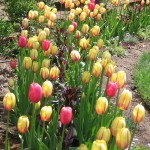 SPRING—(BEGINNING OF APRIL TO MID JUNE)
SPRING—(BEGINNING OF APRIL TO MID JUNE)
- Cut back all perennials to ground level that where left in place through the winter months. Rake up or blow out left over leaves from previous fall. Iris needs special attention at this time. Cut back old leaves and clean them down to the rhizome. Do not mulch. Remove any soft or rotting rhizomes and check for Iris bore. Discard or compost the old foliage and leaves. (See enclosure for composting guide.)
- Unwrap evergreens. Spray with deer repellent if necessary.
- Start annual seeds indoors in late March or early April.
- Pull back mulch materials for spreading plants to allow them to mature. If the garden needs it, add mulch materials at this time for weed control and moisture retention. There should not be more than 3” of wood mulch on your plant material, and never piled on the trunk of trees.
- Divide large perennials and transplant as they crown the surface of the soil.
- Transplant any deciduous shrub before it breaks dormancy. Water thoroughly.
- Selectively prune back ornamental trees, and some types of shrubbery. (See enclosed list) Dormant sprays can be used at this time to help alleviate diseases in ornamental trees.
- Fertilize plant material. Use specialized fertilizers for roses, evergreens, rhododendrons, and azaleas.
Fertilize perennials once per month, and trees and shrubs up until July.
- Use systemic herbicides around ornamental shrubs and trees.
- Put down slug bait around hostas or ground covers if necessary.
- Apply pre-emergent to areas that you don’t want weed seeds to germinate in. This will have to be repeated several times during the year.
- Pull or spray weeds immediately as they begin to grow.
- Plant annuals and vegetables after danger of frost.
- Make sure garden stays properly watered once coming out of dormancy.
- Prune evergreens after new growth has grown.
- Put cages over the areas where perennials need additional support.